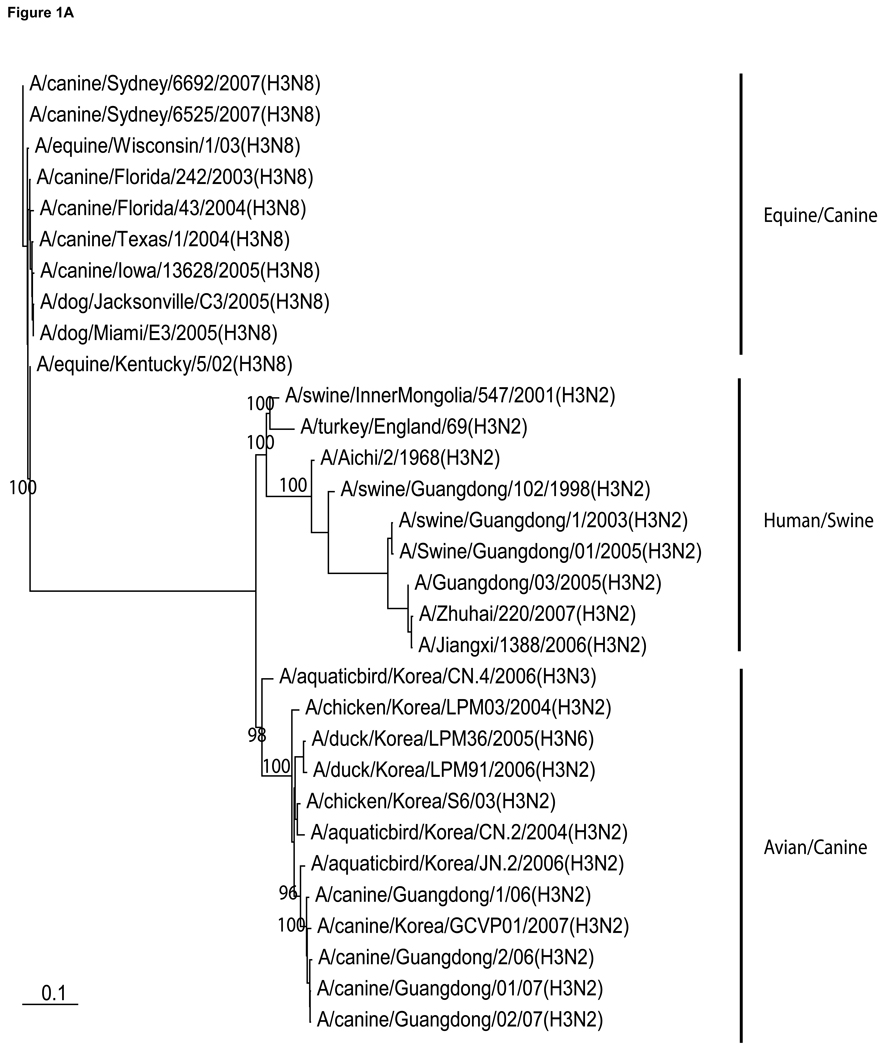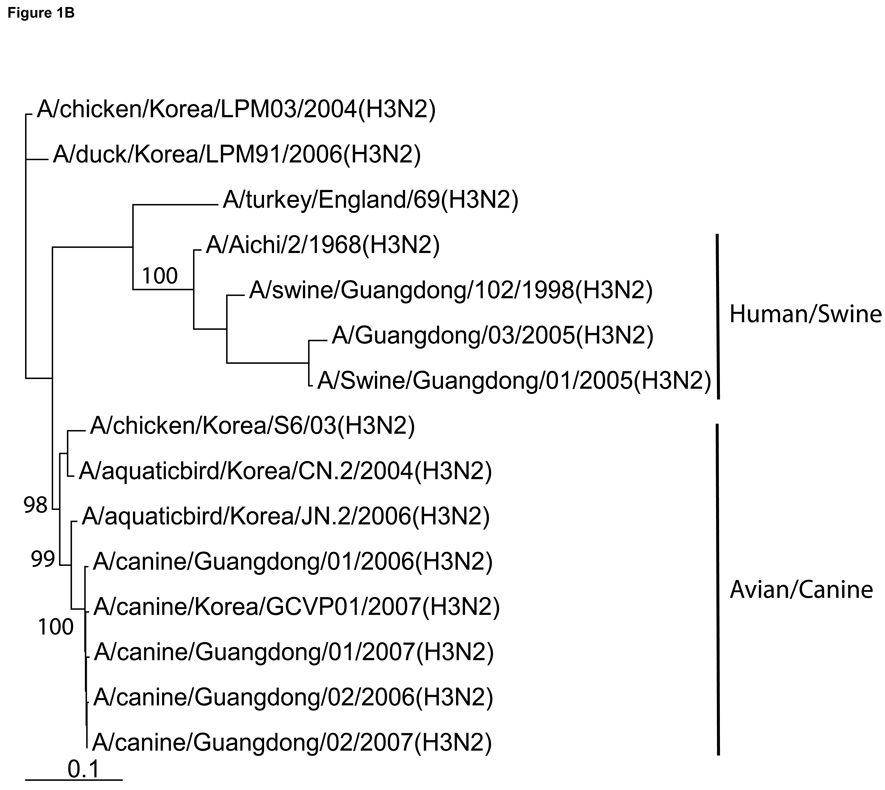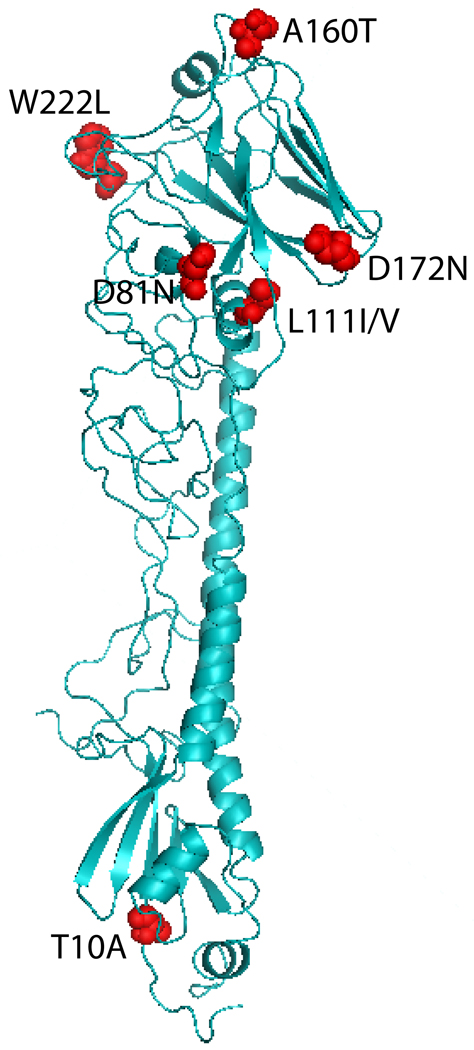Abstract
This study reports four sporadic cases of H3N2 canine influenza in southern China, which were identified from sick dogs from May 2006 to October 2007. The evolutionary analysis showed that all eight segments of these four viruses are avian-origin and phylogenetically close to the H3N2 canine influenza viruses reported earlier in South Korea. Systematic surveillance is required to monitor the disease and evolutionary behavior of this virus in canine populations in China.
Keywords: H3N2, Canine influenza virus, phylogenetics, influenza A virus, pathogenesis, avian-origin
The first documented canine influenza infection was probably caused by the early variants of the pandemic H3N2 influenza A virus (Kilbourne and Kehoe, 1975). However, the laboratory confirmed case of canine influenza was not reported until 2004, and that case was caused by an equine-origin H3N8 influenza A virus (Crawford et al., 2005). Infection experiments showed that this H3N8 virus could reproduce respiratory disease in dogs (Deshpande et al., 2009), and this disease is seemingly epidemic in dog populations in North America (Kruth et al., 2008; Payungporn et al., 2008). A report of similar H3N8 canine cases in United Kingdom (Daly et al., 2008) indicated that this virus had spread across the Atlantic boundary, possibly through pet dog exchange.
During the 2003–2004, highly pathogenic H5N1 avian influenza (HPAI) outbreaks in southeastern Asia, an H5N1 canine case was reported in Thailand (Songserm et al., 2006). The results from animal infection experiments suggested that H5N1 HPAIV could infect dogs but was not fatal. These experiments demonstrated also that this H5N1 virus could neither be transmitted between dogs nor between dogs and cats (Giese et al., 2008).
In 2007, another canine infection was reported in a pet dog in the Republic of Korea (Song et al., 2008). This case was caused by a H3N2 avian-origin canine influenza virus (CIV), which infected dogs successfully through nasal inoculation or contact (respiratory fluid exchange) under experimental conditions (Song et al., 2008). The serological survey in 829 serum samples (361 farmed dogs and 468 pet dogs) collected between June and December 2007 across Korea showed that the canine populations investigated had a serum conversion rate of 19% with anti-influenza viral antibody, and that one farm had a serum conversion rate in dogs of 100% (Lee et al., 2009). This surveillance result suggested strongly that H3N2 avian-origin CIV had been circulating in the canine population in Korea.
From May 2006 to October 2007, the Animal Clinics at the South China Agricultural University received four canine patients with severe respiratory syndrome (Table 1). Two of these dogs were from Guangzhou and the other two from Dongguan, a city located about 50 kilometers southeast of Guangzhou. These dogs showed similar symptoms of coughing, sneezing, copious nasal discharge, and low fever (39.6~39.9°C) when the dogs entered the clinics. The two cases in 2007 were treated with ribavirin and recovered from the disease.
Table 1.
Four avian-origin H3N2 canine influenza cases occurred in southern China (2006–2007)
| Case ID |
Species | Dog residence | Date | Age | Sex | Symptom(s) | Treatment(s) | Disease History | Isolatea |
|---|---|---|---|---|---|---|---|---|---|
| 1 | Cocker Spaniel | Guangzhou | May 26, 2006 | 2-month-old | Male | Cough, sneeze, nasal discharge, body temperature: 39.7°C | cefoselis (22 mg/kg by weight) for 10 days | This pet dog was bought from pet market 3 days before sending to the hospital. The dog died after 2 weeks. | A/canine/Guangdong/01/2006 |
| 2 | Mini-Poodle | Guangzhou | August 17, 2006 | 6-month-old | Male | Cough, sneeze, nasal discharge, low appetite, body temperature: 39.6°C | cefoselis (22 mg/kg by weight) for 4 days | This pet dog died 4 days after being received at the animal clinics. This dog was raised in a flat in the city, and the history of its contacts with other dogs is not clear. | A/canine/Guangdong/02/2006 |
| 3 | Japanese Akita dog | Dongguan | April 13, 2007 | 18-month-old | Male | Productive cough, sneeze, nasal discharge, body temperature: 39.8°C | ribavirin (15mg/kg by weight) for 5 days | This dog recovered one week after being received at the animal clinics. This dog was raised in a rural area as a guard dog, and it had limited contacts with other dogs. | A/canine/Guangdong/01/2007 |
| 4 | Chinese native dog | Dongguan | October 6, 2007 | 3.5-year-old | Female | Cough, sneeze, nasal discharge, body temperature: 39.9°C | ribavirin (15mg/kg by weight) for 5 days | The dog recovered 10 days after being received at the animal clinics. This dog was raised in a rural area as a guard dog, and it has limited contacts with other dogs. | A/canine/Guangdong/02/2007 |
The sequences for these isolated were deposited in GenBank with the accession number GU433345-GU433376.
Nasal swabs were collected from these sick dogs, and viral isolation was performed using 9- to 11-day-old embryonated SPF chicken eggs. Four influenza A viruses were isolated: A/canine/Guangdong/01/2006(H3N2), A/canine/Guangdong/02/2006(H3N2), A/canine/Guangdong/01/2007(H3N2), and A/canine/Guangdong/02/2007(H3N2). The genomes of these viruses were fully sequenced as described before (Wan et al., 2005) and deposited in GenBank with the accession number GU433345-GU433376.
Evolutionary analyses showed that all eight genes of these four viruses were phylogenetically close to H3N2 AIVs as well as to the H3N2 CIV isolated in Korea in 2007 (Figure 1 and SFigure 1). With high nucleotide sequence similarities between these four isolates and the AIVs (HA, 97.7%; NA, 97.8%; PB2, 97.2%; PB1, 97.5%; PA, 98.3%; NP, 96.1%; MP, 98.3%; NS, 94.7%), these H3N2 CIVs were most likely of avian origin. No reassortments were observed in these H3N2 CIVs. In comparison with contemporary H3N2 AIVs present in Eastern Asia, the HA protein in these four isolates has six mutations in HA1 (T10A, D81N, L111I/V, A160T, D172N, W222L) (Figure 2) and one mutation in HA2 (D489N). Among these mutations, the position 222 is located in the 220 loop, which is critical for receptor binding. Further experiments are required to test whether these mutations are required for H3N2 virus to jump from bird to dog.
Figure 1. Phylogenetic analysis and molecular characterization of H3N2 canine influenza viruses isolated from southern China.
(A) The phylogenetic tree for HA gene; (B) The phylogenetic tree for NA gene. The phylogenetic trees were constructed using maximum likelihood implemented in GARLI version 0.96, and the bootstrap values were generated using neighborhood joining methods implemented in PAUP* with 1,000 replications.
Figure 2. The mutations in HA protein surface area of H3N2 avian-origin canine influenza viruses.
The template of H3 three-dimensional structure used here is 1HGD, which is downloaded from the Protein Data Bank (www.pdb.org).
From December of 2009 to January of 2010, based on hemagglutination inhibition assays, our passive serological survey in the pet dog population at Guangzhou area showed that about 6.7% of the 58 dog sera samples were positive. Although it is still very limited, this survey suggested it would be possible that H3N2 avian-origin CIV is circulating in the dog population in Southern China. A more systematic and active survey is still ongoing in the dog population, especially in the dog farms in Southern China.
In summary, we isolated four strains of H3N2 avian-origin CIVs in dogs in southern China. Our results suggest that all eight genes of these viruses were phylogenetically close to one H3N2 Korean CIV available in GenBank, which was likely to be circulating in Korean dog population. The sporadic cases in southern China reported in this study and a limited serological survey indicate this H3N2 virus could have been circulating in canine population. This virus could have been transmitted between Korea and China through pet dog exchange. The emergence of these canine influenza cases in China could result also from the ecological changes in China, especially as the changing of soci-economic circumstances in the last 15 to 20 years in China have led to more people, particularly in urban areas, having companion dogs and dogs continuing to be raised for food, in some circumstances. A systematic surveillance of H3N2 CIV is required to monitor the disease and evolutionary behavior of this virus in canine populations, especially in eastern Asia.
Supplementary Material
Acknowledgments
S. Li, G. Zhang, and M. Liao were supported by the National Natural Science Foundation (No. 30972233) of China, the Natural Science Foundation of Guangdong Province (No. 8251064201000008 and No.8451064201001132), the Basic Conditions for Science and Technology Projects of Guangdong Province (No. 2008A060202017), and the Program for Changjiang Scholars and Innovative Research Team in University (No. IRT0723). L. Long, Z. Cai, and X.-F. Wan was partially supported by NSF-EPS-0903787 subaward 012156-007 to XFW.
Footnotes
Publisher's Disclaimer: This is a PDF file of an unedited manuscript that has been accepted for publication. As a service to our customers we are providing this early version of the manuscript. The manuscript will undergo copyediting, typesetting, and review of the resulting proof before it is published in its final citable form. Please note that during the production process errors may be discovered which could affect the content, and all legal disclaimers that apply to the journal pertain.
References
- Crawford PC, Dubovi EJ, Castleman WL, Stephenson I, Gibbs EP, Chen L, Smith C, Hill RC, Ferro P, Pompey J, Bright RA, Medina MJ, Johnson CM, Olsen CW, Cox NJ, Klimov AI, Katz JM, Donis RO. Transmission of equine influenza virus to dogs. Science. 2005;310:482–485. doi: 10.1126/science.1117950. [DOI] [PubMed] [Google Scholar]
- Daly JM, Blunden AS, Macrae S, Miller J, Bowman SJ, Kolodziejek J, Nowotny N, Smith KC. Transmission of equine influenza virus to English foxhounds. Emerg Infect Dis. 2008;14:461–464. doi: 10.3201/eid1403.070643. [DOI] [PMC free article] [PubMed] [Google Scholar]
- Deshpande M, Abdelmagid O, Tubbs A, Jayappa H, Wasmoen T. Experimental reproduction of canine influenza virus H3N8 infection in young puppies. Vet Ther. 2009;10:29–39. [PubMed] [Google Scholar]
- Giese M, Harder TC, Teifke JP, Klopfleisch R, Breithaupt A, Mettenleiter TC, Vahlenkamp TW. Experimental infection and natural contact exposure of dogs with avian influenza virus (H5N1) Emerg Infect Dis. 2008;14:308–310. doi: 10.3201/eid1402.070864. [DOI] [PMC free article] [PubMed] [Google Scholar]
- Kilbourne ED, Kehoe JM. Demonstration of antibodies to both hemagglutinin and neuraminidase antigens of H3N2 influenza A virus in domestic dogs. Intervirology. 1975;6:315–318. doi: 10.1159/000149485. [DOI] [PubMed] [Google Scholar]
- Kruth SA, Carman S, Weese JS. Seroprevalence of antibodies to canine influenza virus in dogs in Ontario. Can Vet J. 2008;49:800–802. [PMC free article] [PubMed] [Google Scholar]
- Lee C, Song D, Kang B, Kang D, Yoo J, Jung K, Na G, Lee K, Park B, Oh J. A serological survey of avian origin canine H3N2 influenza virus in dogs in Korea. Vet Microbiol. 2009;137:359–362. doi: 10.1016/j.vetmic.2009.01.019. [DOI] [PubMed] [Google Scholar]
- Payungporn S, Crawford PC, Kouo TS, Chen LM, Pompey J, Castleman WL, Dubovi EJ, Katz JM, Donis RO. Influenza A virus (H3N8) in dogs with respiratory disease, Florida. Emerg Infect Dis. 2008;14:902–908. doi: 10.3201/eid1406.071270. [DOI] [PMC free article] [PubMed] [Google Scholar]
- Song D, Kang B, Lee C, Jung K, Ha G, Kang D, Park S, Park B, Oh J. Transmission of avian influenza virus (H3N2) to dogs. Emerg Infect Dis. 2008;14:741–746. doi: 10.3201/eid1405.071471. [DOI] [PMC free article] [PubMed] [Google Scholar]
- Songserm T, Amonsin A, Jam-on R, Sae-Heng N, Pariyothorn N, Payungporn S, Theamboonlers A, Chutinimitkul S, Thanawongnuwech R, Poovorawan Y. Fatal avian influenza A H5N1 in a dog. Emerg Infect Dis. 2006;12:1744–1747. doi: 10.3201/eid1211.060542. [DOI] [PMC free article] [PubMed] [Google Scholar]
- Wan XF, Ren T, Luo KJ, Liao M, Zhang GH, Chen JD, Cao WS, Li Y, Jin NY, Xu D, Xin CA. Genetic characterization of H5N1 avian influenza viruses isolated in southern China during the 2003-04 avian influenza outbreaks. Arch Virol. 2005;150:1257–1266. doi: 10.1007/s00705-004-0474-9. [DOI] [PubMed] [Google Scholar]
Associated Data
This section collects any data citations, data availability statements, or supplementary materials included in this article.





